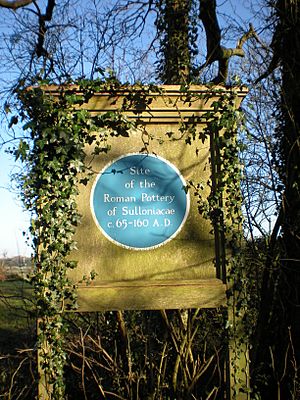Sulloniacis facts for kids
Quick facts for kids Sulloniacis |
|
|---|---|
 |
|
| Location | England, UK |
| OS grid reference | TQ174940 |
| Lua error in Module:Location_map at line 420: attempt to index field 'wikibase' (a nil value). | |
Sulloniacis was a special stop along a Roman road called Watling Street in Roman Britain. It was like a rest stop or inn for official travelers in the Roman Empire. We know about Sulloniacis from an old Roman travel guide called the Antonine Itinerary.
This guide listed routes and places where people could change horses or stay overnight. Sulloniacis was on a route between Richborough (called Portus Ritupis by the Romans) and Chester (called Deva Victrix). It was about nine Roman miles from St Albans (Verulamium) and 12 Roman miles from London (Londinium). Today, many experts believe the remains of Sulloniacis are found at Brockley Hill near Edgware in London.
Contents
What Does the Name Sulloniacis Mean?
The name Sulloniacis might mean 'Estate of Sullonios's family'. Sullonios would have been a person's name, but we don't know it from anywhere else. It's also possible the name described a natural feature of the land.
Where Was Sulloniacis Really Located?
People started looking for Sulloniacis in 1937. Since then, small digs have found many interesting things at Brockley Hill. They found 14 old kilns (ovens for making pottery) and workshops. They also found pits where clay was dug, places to prepare the clay, and wells.
Evidence shows that people lived and worked there from about AD 60. Pottery making was very busy until the end of the first century AD. Around AD 160, pottery production stopped. After that, it became a place where people lived until the fourth century AD. Many believe this settlement was the Sulloniacis mentioned in the Roman travel guide.
Why Some Experts Disagree on the Location
However, not everyone agrees that Brockley Hill is definitely Sulloniacis. Harvey Sheldon, a Roman London expert, has some doubts. While pottery workshops and homes were found, modern digs haven't found any signs of mutationes (places to change horses) or mansiones (places for official travelers to stay). These would have been important parts of a Roman road stop.
Sheldon has suggested other possible locations for Sulloniacis. One idea is further south, near Edgeware Road in Burnt Oak Broadway. Roman remains have already been found nearby by the Hendon and District Archaeological Society. It's also possible that all these places, including a site on Hendon hill, were part of a larger area known as Sulloniacis.
Sulloniacis Pastures: A Special Nature Area
Right next to the Brockley Hill archaeological site, there's a special nature area called Sulloniacis Pastures. It's about 4.2 hectares (10.4 acres) of grassland. This area is important for nature and is protected.
The land slopes up from the A41 road. Because it's on London Clay, it has many wildflowers that like clay soil. You can find plants like greater bird's-foot-trefoil and burnet-saxifrage growing there.
Images for kids


